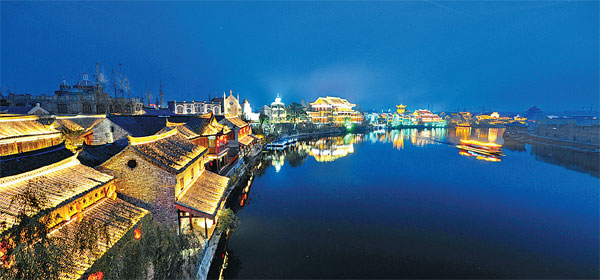Grand Canal lives on in Tai'erzhuang
Flow of history still evident in time-honored trade stop, Wang Qian reports.
The ancient water town of Tai'erzhuang alongside the Beijing-Hangzhou Grand Canal is an alluring tourism destination, a rare site where the original beauty and cultural legacies of the world's oldest manmade waterway remain alive today.
The 1,794-kilometer-long Grand Canal, nine times longer than the Suez Canal, linked northern and southern China and served as a lifeline for dynasties for 14 centuries. It joined the list of World Cultural Heritage sites on June 22.
|
The 1,794-kilometer-long Grand Canal served as a lifeline for dynasties across 14 centuries. |
Located in Zaozhuang city of southwestern Shandong province where a significant section of the canal still functions, Tai'erzhuang has spectacular canal legacies, said experts, including ancient sluices, wharfs and revetments, making it an important part of the application for the World Cultural Heritage list.
The ancient town of Tai'erzhuang was established in the Han Dynasty (206 BC-AD 220), but didn't really come alive until the Jia Canal was built during the Ming Dynasty (1368-1644).
Colloquially known as the "canal of pounded locks", the Jia had eight locks to control water levels.
Tai'erzhuang had the first lock for barges to pass through, sited where the water enters Shandong from the south.
"In ancient times, passing through a lock took several weeks and sometimes up to one month," said Wang Guangjin, director of the town's managing committee."So merchants had to stay in Tai'erzhuang, which boosted the town's economy and made it prosperous overnight."
According to the Annals of Yi County published in 1904, around 10,000 boats passed through Tai'erzhuang on the canal every year, making it an important transport and trading hub during the Ming and Qing dynasties.
Because of the canal, businessmen from around the country and even the world converged at Tai'erzhuang.
They left behind great legacies including more than 6,000 houses and buildings with different architectural styles - some in classical building styles from both the north and south of China, and others of European design.The beauty and prosperity of the town even beckoned the Emperor Qianlong of the Qing Dynasty (1644-1911).
The emperor once called Tai'erzhuang "the most affluent town in the world" and created many legends when he stopped by on his way south via canal, according to the Annals.
Today, tourists can tour the town by boat along the 3-kilometer-long section of the canal, said to be the only stretch unchanged and still functioning since the Ming Dynasty.
"Most docks and mooring points along the canal have been changed or renovated by modern development, but Zaozhuang has a passage along which 13 docks made of natural stone and mooring points are original," Wang says.
Some of them are now used by tourists to reach their destination by boat. After visiting the waterway and docks in 2005, Eric Peterson, an expert from World Tourism Organization, was especially impressed because he daydreamed about China's Grand Canal.
When he finally saw it, he found it was as amazing as he imagined.
Expo park
Wang Hui, chief executive of Tai'erzhuang district, said "the canal caused the country's merchants to converge in the ancient town, bringing diverse traditional cultures, folk arts, customs, and beliefs".
"They are the soul of the town and what most attracts tourists."
To show and protect the cultural resources, a 10,000-square-meter national expo park for intangible cultural heritage, the only one of its kind in China, was built along a boat-shaped street in the town. Wang said 156 national and provincial-level heritage items from across the nation are on display, ranging from clay sculpture from Beijiang and oilpaper umbrellas from Luzhou to traditional New Year woodprint painting from Weifang, Shandong province.
Tourists can see how the crafts are made or try their hand at making their own.
Folk artists are invited to perform in the town every day. Most are inheritors of centuries-old traditions now at risk of vanishing.
They include Liuqin Opera, storytelling in local dialect with drum accompaniment, and Zaozhuang shadow puppetry.
For history buffs, more than 40 museums in the town display diverse traditions such as Chinese traditional medicine and liquor. At the head of the boat-shaped street stands China's first museum of shop signs. It showcases more than 500 shop signs ranging from the Ming Dynasty through to the Republic of China period.
Visitors can also hear 60 calls used by shop owners to attract the attention of customers."We want to show a miniature of Chinese culture by these museums, intangible cultural heritage items and folk art performances," Wang said.
That was validated when Rieke Caroline, a Bolivian candidate for Miss Tourism World, visited Tai'erzhuang in 2010. "To know Tai'erzhuang is to know China," she said.
Contact the writer at wangqian2@chinadaily.com.cn





















